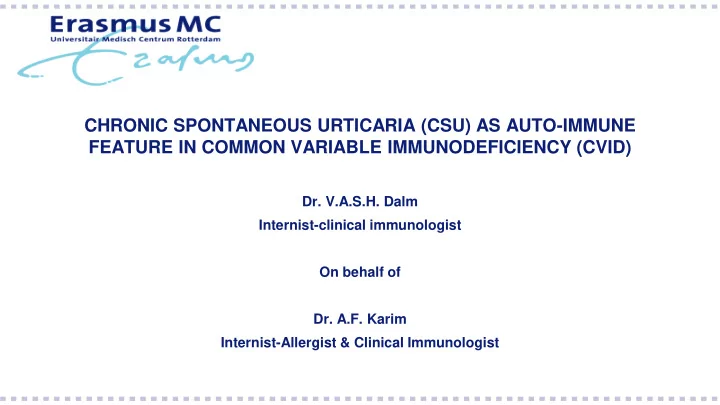

CHRONIC SPONTANEOUS URTICARIA (CSU) AS AUTO-IMMUNE FEATURE IN COMMON VARIABLE IMMUNODEFICIENCY (CVID) Dr. V.A.S.H. Dalm Internist-clinical immunologist On behalf of Dr. A.F. Karim Internist-Allergist & Clinical Immunologist
CVID ▪ Common variable immunodeficiency (CVID) is one of the most common primary humoral immunodeficiencies among adults ▪ Characterized by increased risk of infections, auto-immunity, auto-inflammation, malignancy
Chronic spontaneous urticaria (CSU) ▪ CSU is characterized by the presence of wheals and angioedema for at least six consecutive weeks ▪ Common disorder ▪ Auto-allergic condition ▪ Associated with various auto-immune diseases including auto-immune thyroiditis and systemic lupus erythematosus (SLE) ▪ The association between CSU and CVID is rare Zuberbier T et al. Allergy 2018
Patient 1, male, 42 years old ▪ Unremarkable medical history ▪ Since 6 months episodes of CSU and angioedema ▪ Medical examination: no abnormalities except small lymph nodes neck and groins ▪ Lab: total IgE < 2 kU/L
Patient 1, male, 42 years old Multiple weakly FDG-avid lymph nodes neck, axilla, mediastinum, lung hili, para-iliacal region, groins. Weakly increased uptake spleen. Patchy uptake right lung (CT: no nodules or bronchiectasis).
Additional diagnostics ▪ Bone marrow exam: no lymphoma, no mastocytosis ▪ Lymph node excision: reactive pattern ▪ Additional lab: ▪ Low IgG (420 mg/dl = 4.2 g/L) and IgA (37 mg/dl = 0.37 g/L), normal IgM (96 mg/gl = g/L) ▪ Low total memory B-cells ▪ Disturbed response to immunization with polysaccharide pneumococcal vaccination
Conclusion ▪ CVID ▪ With chronic spontaneous urticaria ▪ Treatment ▪ Omalizumab ▪ Excellent response despite nondetectable IgE! ▪ Effect started 1 month after 2nd injection. ▪ No treatment for CVID (no infections and no bronchiectasis)
Patient 2, female, 52 years old ▪ Medical history: ▪ thyroiditis ▪ auto-immune hemolytic anemia ▪ thrombocytopenia ▪ recurrent respiratory tract infections ▪ bronchiectasis on CT-scan ▪ CSU with moderate response to antihistamines This photo is used with the consent of the patient.
Diagnostics ▪ Slightly decreased number of total thrombocytes ▪ Undetectable levels of IgG, IgA, IgM and IgE ▪ CT-scan: consolidative nodule and bronchiectasis
Conclusion ▪ CVID with auto-immune features and GL-ILD ▪ With chronic spontaneous urticaria ▪ Treatment ▪ Immunoglobulin replacement therapy (IVIG) ▪ Initially prednisone, but because of progression of GL-ILD mycophenolate mofetil and rituximab ▪ Response: currently free of infections, remission of ILD and remission of CSU
Chronic spontaneous urticaria ▪ Frequent urticaria, sometimes with angioedema, > 6 weeks ▪ Association with auto-immune diseases ▪ Up to 50% is ANA positive
Pathophysiology of CSU in CVID ▪ Auto-immune ▪ Antibodies against the high affinity IgE receptors ( FcεRIα) ▪ Antibodies against IgE molecules Bracken et al. Frontiers Immunology 2019 -Pelaia et al. J Asthma Allergy 2011
Treatment of CSU in CVID ▪ Omalizumab could be an effective treatment option ▪ Omalizumab is a humanized monoclonal IgG1 anti-IgE antibody, which binds to free IgE and inhibits their interaction with the FcεRI receptors on mast cells and basophils, leading to a downregulation of such receptors
Previous reports on CSU and CVID ▪ Aimee Altschul et al. JACI. 2002. ▪ 6 cases of CSU associated with CVID ▪ Ashley A et al. J Am Acad Dermatol. 2007 ▪ A child with CSU associated with CVID ▪ Lopes-Rocha E et al. Rev Alerg Mex. 2017. ▪ A woman with CSU and hypogammaglobulinemia ▪ Barbara Frossi et al. European Medical Journal. 2018. ▪ 3 cases of CSU and CVID ▪ Comberiati P et al. Front Immunol 2019 ▪ 1 patient with CSU and CVID treated with Omalizumab
CSU : another skin condition in CVID? de Wit J et al. Allergy 2019 & IPIC 2019 Madrid Poster 48
Conclusion and discussion ▪ CSU may be associated with CVID ▪ CSU as an auto-immune (auto-allergic) feature of CVID? ▪ Should all patients with CSU be screened for immunodeficiency? ▪ Absolute prevalence probably low ▪ CSU on itself is common (5% of Dutch population gets CSU at least for a short period of time) ▪ Only if total IgE is unndetectable? ▪ Ask for infections
Recommend
More recommend